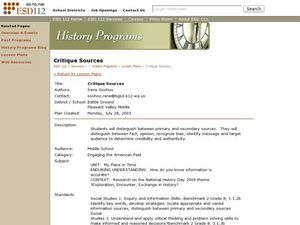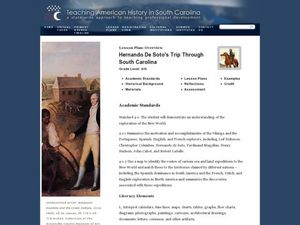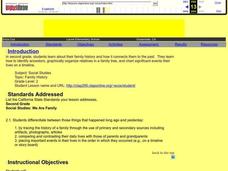Curated OER
Primary Sources and Protagonists: A Native American Literature Unit
Introduce your middle schoolers to the lives of past Native Americans. First, learners work together to put photographs in a sequence. Then, using their sequence, they create stories to share with the whole class. No matter how old your...
University of California
Anti-Communism at Home
Have you ever been accused of something without cause? The sixth installment of an eight-part series asks scholars to create a museum exhibit on the anti-communist activities in the United States at the start of the Cold War. To make...
Curated OER
Cabeza de Vaca Meets the Coahuiltecans
Students examine the difference between primary and secondary sources by examining the journal of Cabeza de Vaca and creating a poster about the Coahuitecan Indian groups. They portray a scene of the groups in 16th Century south Texas.
Curated OER
Critique Sources
Students distinguish between primary and secondary sources. They study about fact, opinion, and recognize bias. Students find out if information is accurate or not and report on it. For the final project students create an annotated...
Curated OER
Establishment of Plainfield
Eighth graders analyze documents and maps of Plainfield, CT from different time periods, then, working in a small group, create a map for a giventime. In this Plainfield instructional activity, 8th graders read primary and...
Curated OER
Japan: Traditions and Culture
Fourth graders explore Japanese customs and history. They create their own works that reflect these traditions. They identify and use primary and secondary sources to learn and communicate about the past.
Curated OER
Learning from Primary Source Documents One Day at a Time
Students differentiate between primary and secondary research sources before making a visual representation of their research into the colonist of Fort St. Louis. They write inquiry questions to guide their research.
Curated OER
History Did Happen in My Back Yard!
Eighth graders interpret historical evidence presented in primary resources. In this Louisiana history lesson, 8th graders research their parish history using the LOUISiana Digital Library resources. Students create multimedia...
Curated OER
Westward Expansion
Students explore the Westward Expansion Movement of U.S. history. For this Westward movement lesson, students use primary and secondary source documents research personal accounts of those who travelled west during the era....
Curated OER
Hernando De Soto's Trip Through South Carolina
Fourth graders become familiar with the explorations of Hernando DeSoto. In this DeSoto lesson plan, 4th graders recognize the routes and territories of DeSoto's explorations. Students use primary and secondary sources and research to...
Curated OER
Site and Situation: Right Place at the Right Time
Middle schoolers put their geography skills to work. In this geography skills lesson, students research maps and other primary and secondary sources to simulate the site selection process for the Pennsylvania Railroad Shops post World...
Curated OER
Red is the Word!
Through the use of stories, artwork, and the KidPix program, youngsters explore the color word red, and engage in activities around the word. Teaching kindergartners about the color words can be so much fun. This could be adapted for any...
Curated OER
Piecing Together the Story of Glenn Cunningham: A Kansas Champion
Learners use primary and secondary sources to conduct research about Glenn Cunningham. In this Glenn Cunningham lesson plan, students tell why he was a hero, and tell facts from what they learned.
Curated OER
Cabeza de Vaca Meets the Coahuiltecans
Seventh graders examine Cabeza de Vaca's journal and differentiate between primary and secondary sources. They, in groups, design posters that portray the culture of the Coahuiltecan Indians in Texas during the 16th century.
Curated OER
Approaching the Iraq War
Learners identify the justifications for the war in Iraq as seen from teh American and Middle Eastern perspectives. They research personal, primary and secondary sources to create a constructed poster board perspective. The poster board...
Curated OER
Student Newspaper Project
Writing teaches us so much. One can identify the many characteristics of a newspaper, use the Internet to gather information, and communicate with others. Primary students create a class newspaper for publishing and dispersal.
Curated OER
Ku Klux Klan
Students discuss, write, and identify symbols of the activities of the Ku Klux Klan in the 1920's in Indiana. In this Ku Klux Klan lesson plan, students also take a field trip to view the Thomas Hart Benton Murals at Indiana University.
Curated OER
A Closer Look at the Klan
Fourth graders learn vocabulary, answer discussion questions, complete writing assignments, and identify symbols connected to the Ku Klux Klan. In this Ku Klux Klan lesson plan, 4th graders also go on a field trip to the Thomas Hart...
Curated OER
Topographic Connections: Earth's Surface Shapes Streams; Streams Sculpt the Earth
Students identify physical characteristics of developing streams and infer changes in the landscape by creating a river model.
Curated OER
We Are Family
Second graders research their family history and how it connects them to the past. They identify their ancestors, graphically organize relatives in a family tree, and chart significant events in their lives on a timeline.
Science Geek
Build a Food Web Activity
Entangle your life science class in learning with this collaborative food web activity. Using pictures of the plants and animals native to a particular ecosystem, young biologists work in small groups to construct visual...
Curated OER
The Significant Contributions of Islamic Women to the Growth and Expansion of Islamic Civilization
Students read and explore the historical evidence that supports the viewpoint that Islamic women have made significant and lasting contributions to Islamic Civilization. They read and analyze secondary and primary sources relevant to...
Curated OER
Historical Maryland Women
Learners identify objects, activities, and people in pictures of women in Maryland's history. In groups of four, they analyze photo packets of historical women. Students complete an acrostic using phrases reflecting specific...
Curated OER
Ancestors in the Americas: Lesson One
High schoolers are introduced to the characteristics of documentaries and making films. Individually, they write their own proposal for an idea of a documentary making sure to identify the point of view of which it is going to be...























